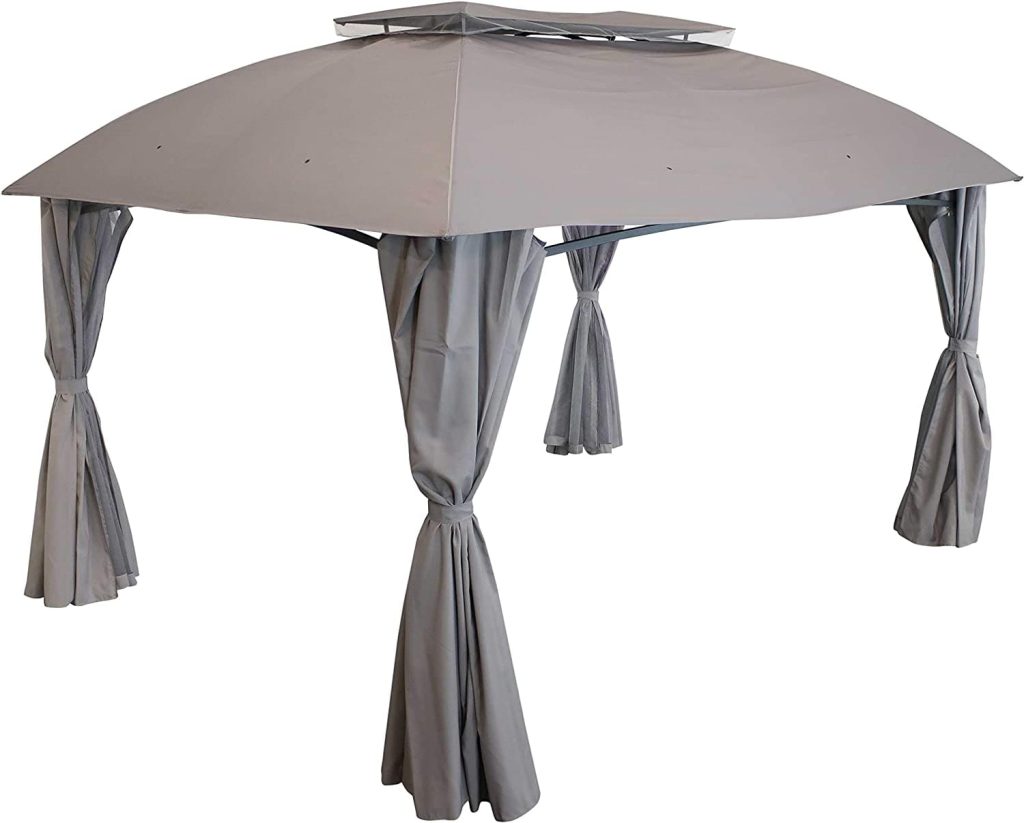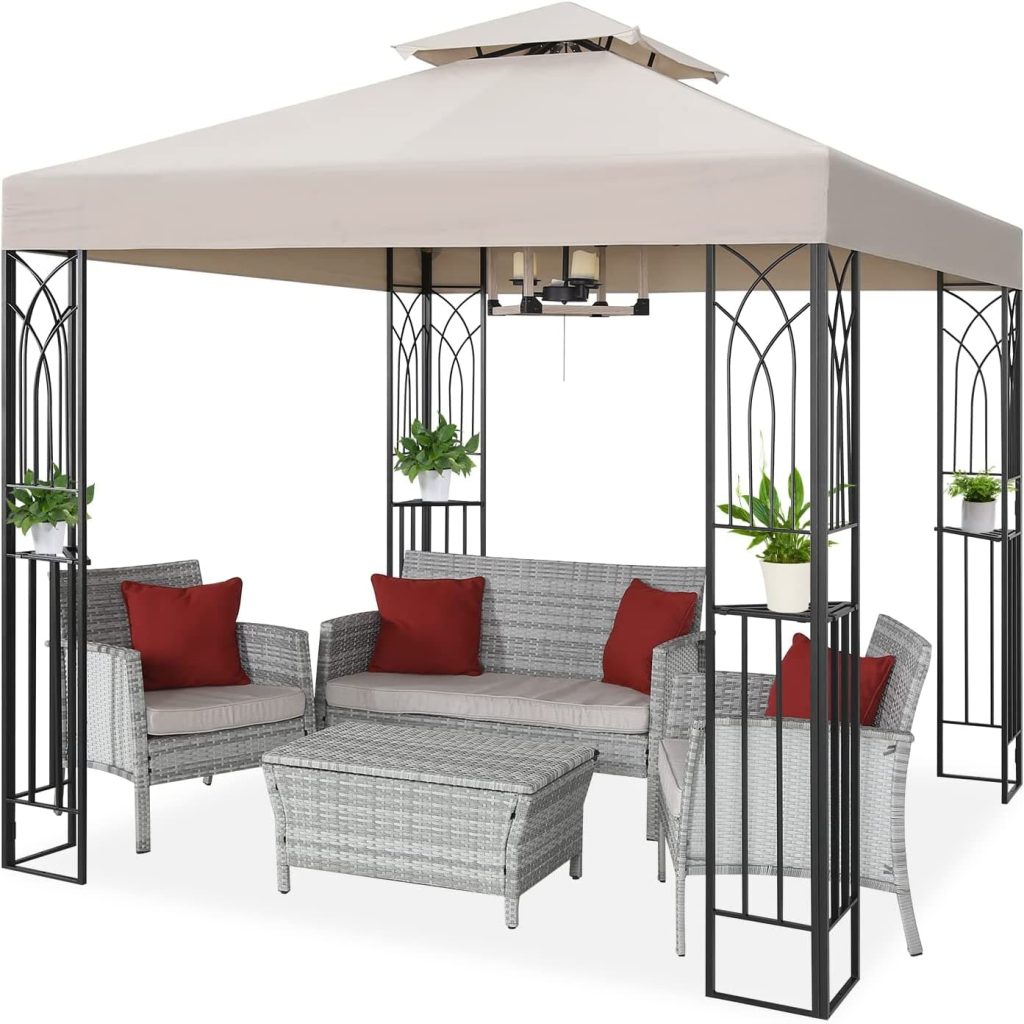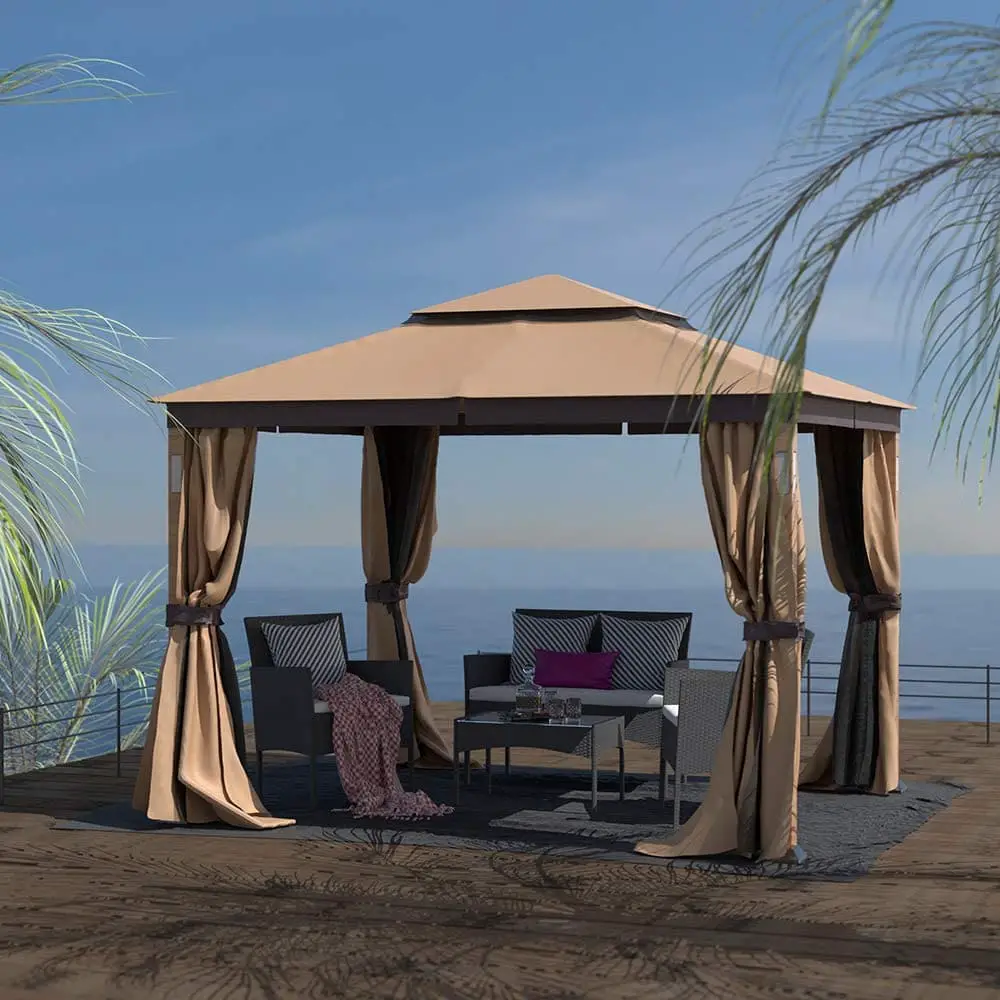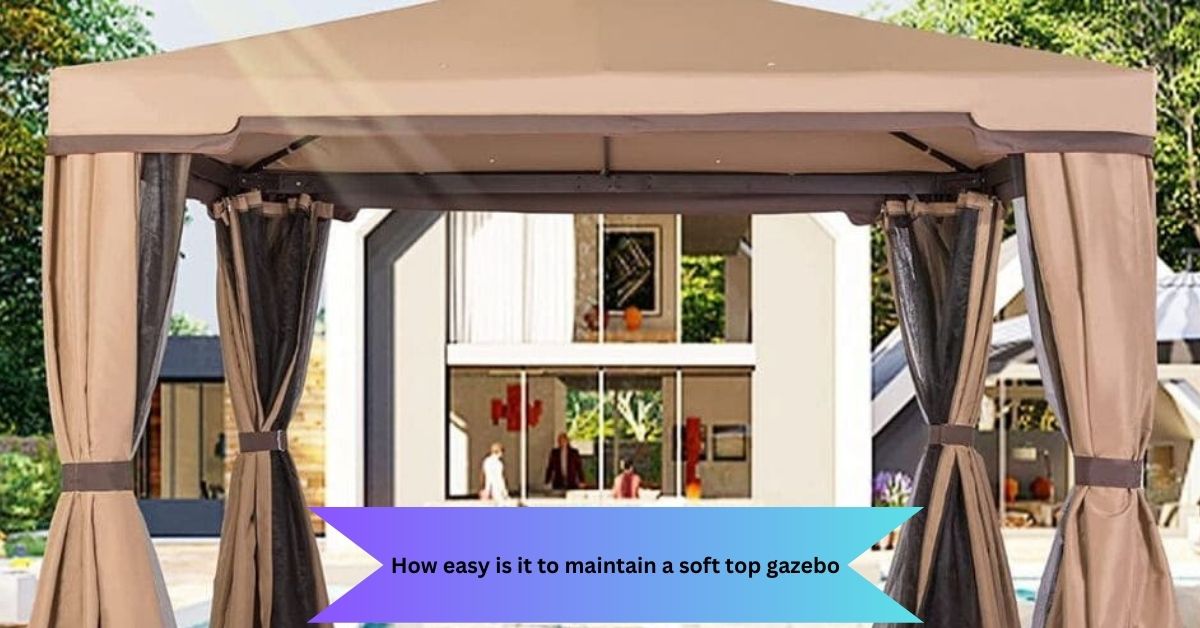A soft top gazebo is a popular outdoor structure that provides shade, shelter, and style to any backyard or garden. Soft-top gazebos are typically made of a fabric canopy supported by a metal frame, which makes them lightweight and easy to move around.
However, like any outdoor structure, a soft top gazebo requires regular maintenance to keep it in good condition and extend its lifespan.
In this article, we will explore the question of how easy it is to maintain a soft top gazebo. We will discuss the cleaning process, repairing common problems, and protecting the structure from the weather and pests.
Additionally, we will provide tips for extending the life of a soft top gazebo. With this information, you can decide whether a soft top gazebo is the right choice for your outdoor space and how to take care of it once you have it.
How easy is it to maintain a soft top gazebo: Maintaining a soft top gazebo is relatively easy. Regular cleaning and proper storage during harsh weather conditions can help prolong its lifespan. Additionally, inspecting and repairing any damages promptly ensures that the gazebo remains in good condition for continued outdoor enjoyment.
How easy is it to maintain a soft top gazebo?

Maintaining a soft top gazebo is not a difficult task. To keep your gazebo looking great, you should regularly clean the canopy with a soft brush or sponge and mild detergent.
It’s important to inspect the frame and hardware for any signs of damage, rust, or wear, and apply protectants to prevent fading and rusting.
During winter, store your gazebo by removing the canopy and disassembling the frame and hardware. With these simple tips, you can easily maintain your soft top gazebo and enjoy it for many years to come.
Factors to consider when maintaining a soft top gazebo
Maintaining a soft top gazebo is essential to extend its lifespan and keep it looking great. Whether you have a small pop-up gazebo or a large permanent structure, regular upkeep is necessary to keep it in top shape. Here are some factors to consider when maintaining a soft top gazebo:
Cleaning and washing
Regular cleaning is one of the most important aspects of maintaining a soft top gazebo. Depending on the frequency of use, you may need to clean your gazebo every few weeks or more often.
Use a mild soap and water solution to remove dirt, stains, and debris from the fabric canopy. Avoid using harsh chemicals or abrasive scrubbers that can damage the fabric.
Start by hosing down the canopy to remove loose dirt and debris. Then, use a soft-bristled brush or sponge to apply the soap solution and scrub the fabric.
Rinse thoroughly with water and let the canopy dry completely before folding or storing it.
Waterproofing
Most soft top gazebos are designed to be water-resistant, but over time, the fabric can lose its ability to repel water. Waterproofing your gazebo periodically can help keep it dry and prevent water damage.
Several types of waterproofing solutions are available, such as sprays or coatings that you can apply to the fabric.
Before applying any product, make sure to read the instructions carefully and test it on a small, inconspicuous area of the canopy first.
Maintenance of the metal frame

The metal frame of a soft-top gazebo also requires maintenance. Regularly inspect the frame for any signs of rust, wear, or damage. If you notice any issues, address them promptly to prevent further damage.
Use a mild soap solution and a soft-bristled brush to clean the metal frame. Avoid using abrasive materials or harsh chemicals that can damage the paint or finish of the frame.
After cleaning, rinse the frame thoroughly with water and let it dry completely.
Storage
Proper storage of a soft top gazebo is essential to prevent damage and prolong its lifespan. When not in use, store the canopy in a cool, dry place, away from direct sunlight or moisture.
Make sure to remove any debris or water from the canopy before storing it.
If you have a larger permanent gazebo, consider removing the canopy during the off-season and storing it indoors. This will protect the fabric from harsh weather conditions and prevent fading or damage.
Prevention of mould and mildew
Mould and mildew can be problematic for soft top gazebos, especially in humid or wet climates. To prevent mould and mildew growth, remove any debris or water from the canopy after rainfall.
If you notice any mould or mildew, clean the fabric with water, vinegar, or a mildew remover product.
Replacement of parts
Over time, parts of a soft top gazebo may need to be replaced due to wear or damage. Check the canopy, frame, and hardware regularly for any signs of wear or damage.
Replace any damaged or worn parts promptly to prevent further damage or safety hazards.
Maintenance of mosquito netting
If your soft top gazebo has mosquito netting, maintain it properly as well. Regularly inspect the netting for any holes or tears and repair them promptly.
You can also wash the netting with mild soap and water to remove dirt and debris.
Maintenance tips for a soft top gazebo

Maintaining a soft top gazebo is crucial for keeping it in good condition and ensuring that it lasts for years. Regular cleaning and protection from the elements are essential to maintain the fabric, frame, and hardware.
Additionally, repairing any damage as soon as possible can prevent further deterioration and keep the structure safe and stable. This article will provide some essential maintenance tips for a soft top gazebo.
Clean the Gazebo Regularly
One of the most important maintenance tasks for a soft top gazebo is regular cleaning. Over time, dirt, debris, and stains can accumulate on the fabric, which can damage the fibres and cause discolouration.
Therefore, it is recommended to clean the gazebo at least once a season or more frequently if it is heavily used or exposed to harsh weather conditions.
To clean a soft top gazebo, start by removing any loose debris with a broom or a soft-bristled brush. Then, mix a solution of mild soap or detergent with water in a bucket. Use a soft sponge or a cloth to gently scrub the fabric, starting at the top and working your way down.
Rinse the fabric thoroughly with a hose or a bucket of clean water, making sure to remove all soap residues. Allow the fabric to air dry completely before folding or storing it.
Protect the Gazebo from the Elements
While soft top gazebos are designed to be lightweight and portable, they are not immune to the effects of weather.
Exposure to sun, wind, rain, and snow can damage the fabric, frame, and hardware over time. Therefore, it is important to protect the gazebo from the elements when not in use.
One way to protect a soft top gazebo is to use a gazebo cover. A gazebo cover is a waterproof, UV-resistant, and breathable fabric that can be fitted over the gazebo to protect it from rain, sun, and dirt.
A good quality gazebo cover can extend the life of the pavilion by preventing water from seeping into the fabric, blocking UV rays that can fade the colour, and reducing the risk of mould and mildew growth.
Another way to protect a soft top gazebo is to take it down during severe weather conditions, such as heavy rain, strong winds, or snowstorms. Soft-top gazebos are not designed to withstand extreme weather; leaving them up during a storm can cause damage or collapse.
If you know that severe weather is on the way, it is best to take down the gazebo and store it indoors until the weather improves.
Repair Any Damage Promptly
Even with proper cleaning and protection, a soft top gazebo can still sustain damage over time. Common problems include tears, rips, holes, fraying, and broken hardware.
If left unattended, these issues can worsen and compromise the stability and safety of the gazebo. Therefore, it is important to repair any damage promptly.
To repair a tear or a hole in the fabric, start by cleaning the affected area with mild soap and water. Allow it to dry completely before applying a patch or repair tape.
Many types of repair tapes are available on the market, such as clear or coloured, waterproof or non-waterproof, and fabric or vinyl.
Choose a repair tape that matches the colour and texture of your gazebo fabric and follow the manufacturer’s instructions for application.
To repair broken hardware, such as a bent or missing pole, start by removing the damaged part from the frame.
Check the manufacturer’s instructions for replacement parts or contact customer service for assistance.
Once you have the replacement part, insert it into the frame and secure it with screws or bolts. Test the stability of the gazebo before using it again.
Store the Gazebo Properly
When the soft top gazebo is not in use, it is essential to store it properly to prevent damage and prolong its lifespan.
Folding and storing the gazebo incorrectly can cause creases, wrinkles, and even tears in the fabric. Therefore, follow these steps to store your soft top gazebo safely:
- Clean and dry the fabric thoroughly before folding it.
- Remove any accessories or decorations from the pavilion, such as lights or curtains.
- Disassemble the frame according to the manufacturer’s instructions.
- Place the fabric on a clean and dry surface, such as a tarp or a clean floor.
- Fold the fabric carefully, following the manufacturer’s instructions, to avoid creases and wrinkles.
- Store the folded fabric in a clean and dry container, such as a storage bag or a plastic bin.
- Store the frame components separately in a dry and secure place to prevent rust or corrosion.
Perform Regular Inspections

In addition to regular cleaning and repairs, it is important to perform regular inspections of the soft top gazebo to ensure that it is safe and stable. Inspections should be performed before each use or at least once a season.
During an inspection, check the following:
- The stability of the frame and the connections between the poles.
- The condition of the fabric, including tears, holes, and fraying.
- The condition of the hardware, including screws, bolts, and brackets.
- The condition of the stakes or anchors, if used.
If any issues are found during the inspection, repair them promptly before using the gazebo again.
Common issues with soft top gazebos
Soft top gazebos are popular outdoor structures that can provide shade, shelter, and comfortable space for outdoor activities.
However, like any outdoor product, they can also experience a variety of common issues that can affect their appearance, function, and lifespan. Here are some common issues with soft-top gazebos:
Wear and tear of the fabric canopy
The fabric canopy of a soft top gazebo is one of the most important components, providing shade and protection from the sun and rain.
Over time, the fabric can experience wear and tear from exposure to the elements, including UV rays, rain, wind, and dirt.
This wear and tear can result in fading, discolouration, stains, tears, and holes in the fabric. While some of these issues can be repaired, extensive damage may require the replacement of the entire canopy.
Rust or corrosion of the metal frame
The metal frame of a soft top gazebo is also susceptible to damage over time, especially if it is exposed to moisture or salt water.
Rust and corrosion can weaken the frame, leading to structural instability and safety hazards.
Regular maintenance of the metal frame can help prevent rust and corrosion. Applying a protective coating or paint can also help extend the frame’s lifespan.
Mould and mildew growth
Soft top gazebos are prone to mould and mildew growth, especially in humid or damp environments. This can cause unsightly stains and odors and health hazards for those with allergies or respiratory issues.
Preventing mold and mildew growth requires regular cleaning and proper storage. Removing any debris or water from the canopy after rainfall can help prevent moisture buildup and mold growth.
Insects and pests
Insects and pests can be a problem for soft top gazebos, especially if they are left uncovered or unattended for long periods. Mosquitoes fly, and other insects can make outdoor activities uncomfortable, while rodents and other pests can cause damage to the structure.
Using mosquito netting or screening can help prevent insects from entering the gazebo, while regular cleaning and maintenance can prevent pests from making the structure they are home.
Wind damage
Soft top gazebos can also experience damage from wind, especially if they are not properly anchored or secured.
High winds can cause the canopy to tear or detach from the frame, leading to safety hazards and damage to the structure.
Proper anchoring and securing of the gazebo can help prevent wind damage. Removing the canopy during strong winds or storms can also help protect the structure.
Water damage
Water damage can occur if a soft top gazebo canopy is not properly waterproofed or if water is allowed to pool on the surface. This can cause the fabric to rot, stain, or become moldy.
Regular waterproofing of the canopy can help prevent water damage while removing any debris or water from the surface after rainfall can prevent pooling and mold growth.
Fading of the fabric

The fabric of a soft top gazebo can also experience fading over time due to exposure to sunlight and UV rays. This can cause the color to fade, making the structure look worn and outdated.
Using a UV-resistant fabric or applying a protective coating can help prevent fading. Proper storage during the off-season can also help prolong the lifespan of the fabric.
Steps to fix common issues
Soft top gazebos are a great way to enhance your outdoor space, but like any outdoor product, they can experience wear and tear over time.
Some common issues that can affect the appearance and function of a soft top gazebo include wear and tear of the fabric canopy, rust or corrosion of the metal frame, mold and mildew growth, insects and pests, wind damage, water damage, and fading of the fabric.
However, these issues can be easily fixed with proper maintenance and care. This article will discuss the steps to fix common issues with a soft top gazebo.
Patching or Replacing the Canopy
The fabric canopy is one of the most important components of a soft top gazebo, providing shade and protection from the elements.
However, over time, the fabric can become damaged due to exposure to UV rays, rain, wind, and dirt. If you notice tears, holes, or other damage to the canopy, it’s important to address the issue before it becomes worse.
Step 1: Assess the Damage
The first step in fixing a damaged canopy is to assess the extent of the damage. Determine if the damage can be repaired or if the entire canopy needs to be replaced.
If the damage is minor, such as a small tear or hole, it may be possible to patch it with a patch kit or fabric tape.
However, if the damage is extensive or the canopy is old and worn, replacing the entire canopy may be more cost-effective.
Step 2: Remove the Old Canopy
If you need to replace the entire canopy, remove the old canopy from the frame. This may require disassembling the gazebo to remove the canopy completely.
Step 3: Install the New Canopy
Once the old canopy is removed, install the new canopy according to the manufacturer’s instructions. Ensure to properly secure the canopy to the frame to prevent damage from wind or other weather elements.
Treating Rust Spots
The metal frame of a soft top gazebo is also susceptible to rust and corrosion, especially if it is exposed to moisture or salt water.
Rust can weaken the frame, leading to structural instability and safety hazards. To prevent rust and corrosion from spreading, addressing any rust spots as soon as possible is important.
Step 1: Clean the Affected Area
Start by cleaning the affected area with a wire brush to remove any loose rust or debris. If the rust spot is particularly stubborn, you may need to use sandpaper or a grinder to remove it completely.
Step 2: Apply Rust Converter
Once the affected area is clean, apply a rust converter to the surface. A rust converter is a chemical solution that converts rust into a stable compound that can be painted over.
Follow the manufacturer’s instructions for application and allow the solution to dry completely before proceeding.
Step 3: Paint the Area
Once the rust converter is dry, paint the affected area with a rust-inhibiting paint. This will help prevent further rusting and protect the metal frame from future damage.
Applying Fabric or Metal Protectant to Prevent Fading or Rusting
Preventing damage to the fabric and metal components of a soft top gazebo is an important part of maintenance. Applying fabric or metal protectant can help prevent fading or rusting and extend the structure’s lifespan.
Step 1: Clean the Surface
Before applying any protectant, it’s important to clean the surface thoroughly. Use mild soap and water to remove dirt or debris from the fabric or metal frame.
Step 2: Apply the Protectant
Apply a fabric or metal protectant according to the manufacturer’s instructions. Fabric protectants can help prevent fading and staining, while metal protectants can help prevent rust and corrosion.
Step 3: Reapply as Needed
After the initial application, it’s important to reapply the protectant on a regular basis, as recommended by the manufacturer.
This will help maintain the protective barrier and ensure that the fabric and metal components of the gazebo stay in good condition.
Additional Maintenance Tips
In addition to the steps outlined above, there are several other maintenance tips you can follow to keep your soft top gazebo in good condition:
- Clean the canopy regularly with a mild soap and water solution to remove dirt and debris.
- Use a soft brush or sponge to clean the fabric, and avoid using abrasive cleaners or harsh chemicals that can damage the fabric.
- Remove any debris, such as leaves or branches, that may accumulate on the canopy or frame.
- Check the bolts and screws on the frame regularly and tighten them as needed to prevent looseness or wobbling.
- If you live in an area with harsh weather conditions, consider taking down the gazebo during winter to prevent snow or ice damage.
- Store the canopy in a dry, cool place during the off-season to prevent mold or mildew growth.
FAQs
Q.1 How often should I clean the canopy of my soft top gazebo?
It’s recommended to clean the canopy at least once a year to remove any dirt, dust, or debris that can damage the fabric.
Q.2 Can I use a pressure washer to clean my soft top gazebo?
No, you should avoid using a pressure washer to clean the canopy or frame, as it can damage the fabric or hardware. Instead, use a soft brush or sponge and a mild detergent or soap to gently scrub the canopy.
Q.3 How do I store my soft top gazebo during the winter months?
Remove the canopy and clean your soft top gazebo to store it. Disassemble the frame and hardware and store them in a dry, cool place. Roll up the canopy and store it in a dry, cool place like a closet or basement.
Q.4 Can I leave my soft top gazebo up all year round?
It’s not recommended to leave your soft top gazebo up all year round, as harsh weather conditions, such as heavy snow or strong winds can damage it. It’s best to store the gazebo during the off-season to prevent any damage or wear.
Q.5 How do I prevent rust spots on my soft top gazebo frame?
You can apply a rust inhibitor or metal protectant to the frame and hardware to prevent rust spots. You can also inspect the frame regularly for any signs of rust or corrosion and remove them as soon as possible.
Conclusion
In conclusion, maintaining a soft top gazebo is not a difficult task, and with expert advice and tips, you can keep it looking new for years to come.
It’s important to regularly clean the canopy, inspect the frame and hardware, and store the gazebo during the off-season.
Factors to consider when maintaining a soft top gazebo include the type of fabric, frame material, and exposure to the elements.
Common issues with soft-top gazebos include canopy damage, rust spots, and fading. However, simple steps can easily fix these issues, such as patching or replacing the canopy, treating rust spots, and applying protectants.
Proper maintenance ensures that your soft top gazebo provides a comfortable and stylish outdoor space for your family and friends to enjoy.
We hope this guide helped you understand how to easily care for a soft top gazebo. If you have any questions, please feel free to ask us by commenting below!

